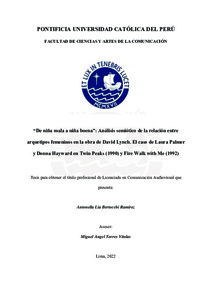| dc.contributor.advisor | Torres Vitolas, Miguel Ángel | |
| dc.contributor.author | Bertocchi Ramirez, Antonella Lia | |
| dc.date.accessioned | 2022-10-04T18:09:27Z | |
| dc.date.available | 2022-10-04T18:09:27Z | |
| dc.date.created | 2022 | |
| dc.date.issued | 2022-10-04 | |
| dc.identifier.uri | http://hdl.handle.net/20.500.12404/23454 | |
| dc.description.abstract | La presente investigación pretende estudiar la construcción y la relación de los arquetipos
femeninos “niña buena” y “niña mala” en la franquicia de Twin Peaks, en específico la
película Fire Walk with Me (1992) y la serie de televisión Twin Peaks (1990) a través de dos
personajes femeninos: Laura Palmer y Donna Hayward. Para ello, se utilizaron los conceptos
de arquetipos planteados por Carl Jung siguiendo los principios de compensación y equilibrio
de opuestos. Como complemento, se identificaron una serie de indicadores que constituyen
cada arquetipo en productos audiovisuales, a partir de investigaciones desarrolladas por Lola
Salcedo, Virginia Guarinos y la agrupación feminista Guerrilla Girls. Finalmente, la principal
herramienta de análisis es la semiótica del texto fílmico y narrativo establecida por Christian
Metz, Desiderio Blanco, Aumont & Marie, y Greimas & Courtés. Esta metodología junto con
el análisis de contenido permiten concluir que los arquetipos “niña mala” y “niña buena” en
Twin Peaks se construyen a partir de imitaciones y oposiciones narrativas y figurativas en las
cuales los arquetipos deben coexistir al mismo tiempo y no pueden existir separados, ya que
necesitan del otro para definirse. Estos arquetipos dicotómicos contestan al estilo propio del
director David Lynch y, aunque la mirada masculina del creador apela a convenciones
patriarcales, los personajes femeninos de Twin Peaks desafían sus propias características al
transitar entre ambos arquetipos y construirse a partir de su relación con la violencia. | es_ES |
| dc.description.abstract | This research aims to study the construction and relationship of the female archetypes “good
girl,” and “bad girl” in the Twin Peaks franchise, specifically in the film Fire Walk with Me
(1992) and the TV series Twin Peaks (1990) through the female characters of Laura Palmer
and Donna Hayward. To achieve this, the researcher used the concepts of archetypes raised
by Carl Jung by following the principles of compensation and equilibrium of opposites. Then,
the researcher identified a series of indicators that establish each archetype in audiovisual
media, according to the studies developed by Lola Salcedo, Virginia Guarinos, and the
feminist group Guerrilla Girls. Finally, the primary analysis tools are film and narrative
semiotics as presented by Christian Metz, Desiderio Blanco, Aumont & Marie, and Greimas
& Courtés. This analysis allows the researcher to conclude that the archetypes “good girl”
and “bad girl” in Twin Peaks are built from narrative and figurative imitations and
oppositions. Therefore, the archetypes must coexist simultaneously and cannot exist
separated because they need each other to be defined. These dichotomous archetypes answer
to the directing style of David Lynch, and even though the male gaze of the creator appeals to
patriarchal conventions, the female characters of Twin Peaks defy their expectations by
transiting between both archetypes and building themselves in relation to violence. | es_ES |
| dc.language.iso | spa | es_ES |
| dc.publisher | Pontificia Universidad Católica del Perú | es_ES |
| dc.rights | info:eu-repo/semantics/openAccess | es_ES |
| dc.rights | Atribución-NoComercial 2.5 Perú | * |
| dc.rights.uri | http://creativecommons.org/licenses/by-nc/2.5/pe/ | * |
| dc.subject | Comunicación audiovisual | es_ES |
| dc.subject | Semiótica | es_ES |
| dc.subject | Cinematografía | es_ES |
| dc.subject | Género | es_ES |
| dc.subject | Mujeres | es_ES |
| dc.subject | Lynch, David, 1946- --Estudio y crítica | es_ES |
| dc.subject | Directores de cine (Lynch) | es_ES |
| dc.title | De niña mala a niña buena: Análisis semiótico de la relación entre arquetipos femeninos en la obra de David Lynch. El caso de Laura Palmer y Donna Hayward en Twin Peaks (1990) y Fire Walk with Me (1992) | es_ES |
| dc.type | info:eu-repo/semantics/bachelorThesis | es_ES |
| thesis.degree.name | Licenciado en Comunicación Audiovisual | es_ES |
| thesis.degree.level | Título Profesional | es_ES |
| thesis.degree.grantor | Pontificia Universidad Católica del Perú. Facultad de Ciencias y Artes de la Comunicación. | es_ES |
| thesis.degree.discipline | Comunicación Audiovisual | es_ES |
| renati.advisor.dni | 10684078 | |
| renati.advisor.orcid | https://orcid.org/0000-0001-5817-9013 | es_ES |
| renati.author.dni | 76217777 | |
| renati.discipline | 211086 | es_ES |
| renati.juror | Rubina Vargas, Celia Isabel | es_ES |
| renati.juror | Torres Vitolas, Miguel Angel | es_ES |
| renati.juror | Vega Oroza, Marianela | es_ES |
| renati.level | https://purl.org/pe-repo/renati/level#tituloProfesional | es_ES |
| renati.type | https://purl.org/pe-repo/renati/type#tesis | es_ES |
| dc.publisher.country | PE | es_ES |
| dc.subject.ocde | https://purl.org/pe-repo/ocde/ford#5.08.00 | es_ES |






